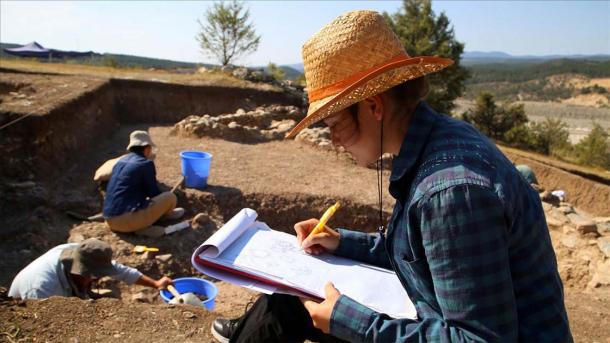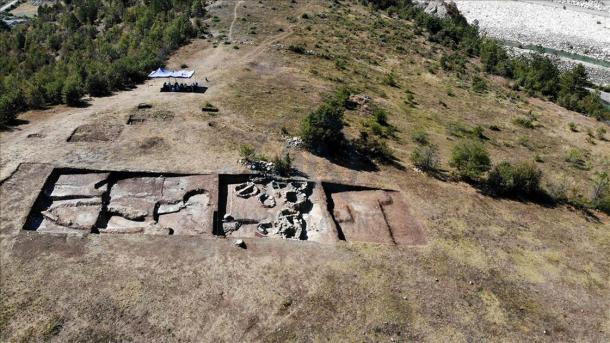Archaeologists at the Kahin Tepe site in Turkey have discovered an ancient temple dating back to the Stone Age, between 7,000 and 12,000 years ago. This could have especially important implications for understanding the prehistory of Anatolia. Moreover, it appears that there may be links between Kahin Tepe and the famed Göbekli Tepe , which has changed our understanding of the evolution of human civilization.
Experts from the Kastamonu Museum Directorate of the Ministry of Culture and Tourism have been working at the Kahin Tepe site that is located in the province of Kastamonu, not far from the Black Sea . The work has been carried out by archaeologists and students as part of a rescue project before the planned construction of a dam. Kahin Tepe is an Aceramic Neolithic settlement, which means that it existed before the invention of pottery.

In a short space of time the Kahin Tepe site has revealed several exciting discoveries. ( Özgür Alantor / Anadolu Agency )
Excavation of Stone Age Settlement Reveals Temple
Dr. Nurperi Ayengin from Düzce University, a consultant on the project, stated that the team “discovered the settlement dating to the Aceramic Neolithic period, which lasted between 12,000 and 7,000 BC.” It was inhabited by a Stone Age Anatolian people . During the 2019 season, several discoveries were made, including a grinding stone and some personal ornaments, both from the Neolithic period . A stone workshop was also found, believed to have been used in the production of sculptures, especially of animals.
During the most recent excavations, the archaeologists found the remains of what they believe was a place of worship. Located at the top of a hill, the remains consist of circular and square stone walls that were clearly planned. Some evidence of standing stones have also been uncovered. Hurriyet Daily News reports that the team believe the remains belong to “the oldest place of worship found in the Black Sea” area.

The Neolithic Kahin Tepe site includes what appears to be one of the oldest temples ever to have been discovered, dating back circa 12,000 years. ( Özgür Alantor / Anadolu Agency )
Artifacts and Motifs of Neolithic Gods
“We think that this was a sacred area where people came at certain times of the year to hunt, share knowledge, worship, and make statues of animals,” explains Ayengin in AA.com. Thanks to some of the artifacts discovered during the excavations, it appears gods in the forms of animals were worshipped at the site. The so-called temple, was built at a strategic location. “This is a place that dominates the plain. I think the people of the era chose this place specifically and consciously,” continues Ayengin. As there was a regular water supply, the inhabitants were able to produce a food surplus, which was crucial in the development of the site.
During an investigation of the artifacts unearthed at Kahin Tepe, the researchers were struck by similarities with those found at Göbekli Tepe , a UNESCO World Heritage Site located in the south-east of Turkey. With large numbers of circular T-shaped pillars, many believe that it is the world’s oldest temple and based on its discovery, many now believe religion played an important role in the growth of civilization. Many of the objects found at Kahin Tepe have been “dated to between 9,000 and 14,000 years old, [and] are similar to those found at the Neolithic site of Göbekli Tepe ,” explains Ayengin in Archaeology.
Linking Kahin Tepe with Göbekli Tepe
There are several other similarities between the two prehistoric temple complexes and settlements. “When we look at the social structure of the period, we know that the main element was a rigid and complex religious belief,” clarifies Ayengin in Hurriyet Daily News . This was the case in Göbekli Tepe , as well as at the Neolithic settlement at Kahin Tepe. This may suggest that the two areas were in contact and may have influenced one another, possibly indicating that the Neolithic societies were much more sophisticated than often believed.
These “new discoveries will change the history of Anatolia,” announces Ayengin in Ancient Pages when discussing Kahin Tepe. Many experts believe that there are more Stone Age settlements in the Anatolian region which has yielded many important archaeological sites which proves the area played an incredibly significant role in the dawn of civilization.
Top image: The remains of an ancient temple have been discovered during the Kahin Tepe excavation in Kastamonu, Turkey. Source: Özgür Alantor / Anadolu Agency
By Ed Whelan
 RSS Feed
RSS Feed















 October 2nd, 2020
October 2nd, 2020  Awake Goy
Awake Goy  Posted in
Posted in  Tags:
Tags: 













